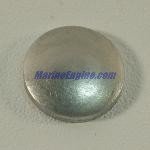Re: What is a "Welch plug?"
Glad it helped Olias.
What I'd suggest you do now if you haven't done this yet, is to get with someone you know who is experienced with outboards and get your motor on a boat or in a water barrel and let them observe it it with you. Let them tell you if they think it is too hot or what's about normal with it. Nothing beats having some experienced friends around who know their outboards.
From what I read in your post, The water coming out at the rear vent "pee hole" if it is a steady stream is a good sign. Mine wasn't doing that when I got it, owing to that welch plug being missing. So my motor got hot quickly as the water wasn't being contained in the water jacket as it was supposed to. That "pee hole" serves to vent the water jacket so that there is no air pocket trapped in the
cooling system that would allow part of the motor to not be cooled. That is an important sign. As a kid, Dad always had me sitting behind him in his old boat and part of my crew duty was to keep an eye on that little stream of water and make sure it was always
there and if not let him know immediately.
As for pulling the motor, commonly called the power head, off the lower unit or "out drive" , on my old Scott Atwater the water pumps (mine has 2) are at the top of the drive shaft. But this will allow you to inspect the bottom of your motor and look down into the out drive. If you want to work on the out drive it is much easier to do this now. Likewise with the motor.
The outboard I have and yours too most likely vents the engine exhaust into the out drive where it does double duty like an exhaust pipe. Water is poured from the motor into this from the engine cooling system at the same time and is ducted out just behind your prop. The out drive is also moving through the water your boat is in and that helps to cool the engine too. But still your engine is going to get hot just like a water cooled car engine. There just isn't a Radiator and fan on it as the cooling system uses water from the lake or river and returns the heated water back to that source. So your cooling will largely depend on the ambient temperature of the water
you are boating on and the ratio of oil to fuel, and to some extent the mixture setting you use will ultimately effect the temperature your motor runs at.
So don't worry too much until you can get with some experienced friends who have their own boats and operate them frequently. They
may offer to take you out and show you how their motor runs and you can see for yourself how hot it gets in normal operation.
This youtube video would give you an idea of what a good running motor would sound and behave like at different speeds of operation.
And a 45 hp Scott on a fiber glass runabout. This is about like my own boat. Yes the motor gets hot during operation, so expect that. If it gets too hot and won't run properly, then it's time to pull it to the bank and check things out.
1961 Sears Elgin - YouTube
That's why Dad had me keeping an eye on that pee hole vent at the back of the engine. He knew if it was flowing a steady stream that the water pump was delivering water into the cooling system.
.





















